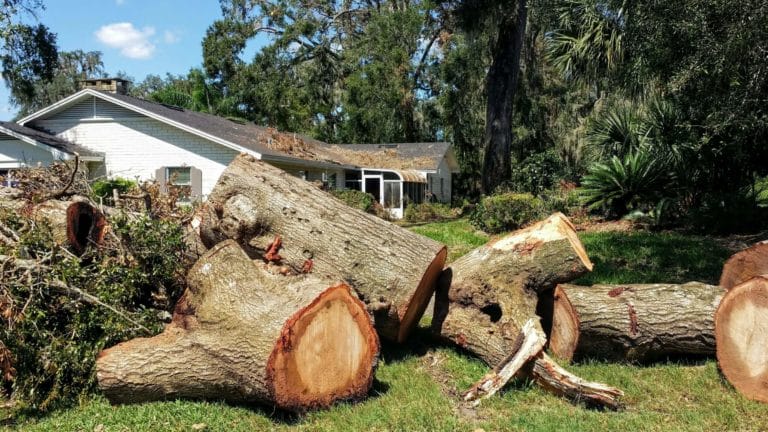Tree removal is expensive due to various factors. These include the size of the tree, its location, accessibility, and the complexity of the job. On average, costs range from $300 to $4,500, but actual expenses may differ.
Why Does Tree Removal Services So Expensive?
Tree removal services can be expensive due to several reasons. Let’s explore some of the main reasons for the high costs associated with tree removal.
1. Complexity of the Job
Tree removal can be a complex and challenging task, especially in certain situations. The complexity of the job can significantly impact the cost of the service.
Difficult Access to Trees
If the tree that needs to be removed is located in a hard-to-reach area, such as a backyard with limited space or a densely populated area, it can increase the cost. In such cases, the tree removal crew may need to use specialized equipment or even a crane to access and safely remove the tree.
Multiple Trees or Large Quantity of Branches
If you need to have multiple trees removed or have a large quantity of branches that need to be trimmed or removed, it can increase the overall cost. The more trees or branches that need to be dealt with, the more labor and time it will require.
Presence of Obstacles or Structures Around Trees
When there are obstacles, such as buildings, fences, power lines, or other structures, near the trees that need to be removed, it adds complexity to the job. The removal crew may need to take extra precautions and use specialized techniques to avoid damage to the surrounding structures.
Sensitivity of Surrounding Area or Landscape
In some cases, the surrounding landscape or area may be sensitive and require extra care during the tree removal process. For example, if there are delicate plants, gardens, or underground utilities, the removal crew may need to take additional measures to protect them, which can increase the cost.
Need for Emergency or Urgent Removal
In emergency situations, such as when a tree is leaning dangerously or has fallen and is blocking a road, the tree removal service may need to prioritize the job and act quickly. Emergency tree removal often requires specialized equipment and immediate response, which can contribute to higher costs.
2. Specialized Equipment and Tools
Tree removal requires specialized equipment and tools to ensure safe and efficient removal. Chainsaws, tree climbers, cranes, chippers, and other machinery are necessary for the job. These tools need to be maintained, repaired, and operated by trained professionals, which adds to the overall cost of the service.
3. Insurance Costs
Tree removal companies need to carry insurance policies to protect their workers, clients, and property during a removal job. The cost of insurance coverage can be significant and is factored into the overall cost of the service.
4. Risk and Safety Precautions
Tree removal is a hazardous job that involves significant risks. The removal crew must take safety precautions to protect themselves, the property, and the surrounding area. This includes wearing proper safety gear, implementing fall protection measures, and following industry-standard safety protocols. These precautions increase the overall cost of the service.
5. Time and Labor Intensity
Tree removal can require a significant amount of time and labor, especially for larger trees or complex jobs. The cost of labor, including the expertise and experience of the tree removal crew, contributes to the overall expense. Additionally, the time required to complete the job can also impact the cost.
6. Environmental Regulations
Tree removal is subject to environmental regulations and permits in many areas. Tree removal companies need to comply with these regulations, which can involve additional paperwork, fees, and inspections. Meeting these requirements adds to the overall cost of the service.
7. Expertise and Training
Tree removal is a specialized skill that requires expertise and training. Arborists and tree removal professionals undergo extensive training to ensure they can safely and efficiently remove trees. Their expertise and knowledge come at a cost, which is reflected in the overall price of the service.
8. Tree Size and Location
The size and location of the tree can greatly influence the cost of tree removal.
Impact of Tree Size on Removal Costs
Larger trees require more labor, specialized equipment, and time to remove compared to smaller trees. The cost of removing a large tree can be significantly higher due to these factors.
Challenges of Removing Large Trees
Removing large trees presents additional challenges and risks. The removal crew may need to use cranes or other heavy machinery to safely bring down and remove the tree. These added challenges contribute to the higher cost of removing large trees.
Location Considerations in Tree Removal
The location of the tree plays a role in determining the cost of removal. If the tree is located in an area with easy access and minimal obstacles, the removal process may be quicker and less expensive. However, if the tree is in a hard-to-reach location or surrounded by delicate structures, the removal cost may increase.
Cost Differences for Trees in Different Locations
The cost of tree removal can also vary based on the geographical location. Factors such as local demand, competition among tree removal companies, and the cost of living in a particular area can influence the pricing.
Factors Influencing the Removal Process Based on Tree Size and Location
The size and location of a tree can impact the removal process. For example, if a large tree is located in a confined space, it may require more careful planning, skill, and equipment to safely remove it. These factors can contribute to the overall cost.
9. Disposal and Cleanup
After a tree is removed, there is a need for disposal and cleanup of the debris. Tree removal companies often charge additional fees for the removal and disposal of tree branches, trunks, and other debris. The cost of disposal and cleanup adds to the overall expense of the tree removal service.
10. Local Demand and Competition
The demand for tree removal services in a particular area can influence the cost. In areas with high demand and limited competition, tree removal services may charge higher rates. Conversely, in areas with more competition, prices may be more competitive.
Tips To Save Money On A Tree Removal
While tree removal can be expensive, there are ways to potentially save money on the service. Here are some tips to consider:
Get Multiple Quotes From Tree Removal Services
Getting quotes from multiple tree removal services can help you compare prices and find the most affordable option. Be sure to assess the reputation and qualifications of each company before making a decision.
Consider the Time of Year for Tree Removal
The timing of tree removal can impact the cost. Some tree removal companies may offer discounted rates during certain times of the year when their services are in lower demand. Consider scheduling the removal during the off-peak season to potentially save money.
Save Money by Removing the Tree Yourself
If you have the necessary skills, equipment, and proper permits, you may be able to remove the tree yourself. However, keep in mind that tree removal can be dangerous, and it’s best to leave it to trained professionals if you are unsure or if the tree is large or complex.
Opt for Tree Trimming Instead of Complete Removal
If the tree is not posing an immediate risk or hazard, you may be able to opt for tree trimming instead of complete removal. Trimming can remove overhanging or damaged branches, improving the tree’s health and reducing the cost compared to full removal.
Reuse or Sell the Wood from the Tree
If the tree being removed is suitable for firewood or lumber, you may be able to sell or reuse the wood. This can offset some of the costs associated with tree removal. In conclusion, tree removal is expensive due to factors such as the complexity of the job, specialized equipment and tools, insurance costs, risk and safety precautions, time and labor intensity, environmental regulations, expertise and training required, tree size and location, disposal and cleanup, and local demand and competition.
However, by understanding these factors and implementing cost-saving tips, you can make informed decisions and potentially reduce the overall expense of tree removal.


